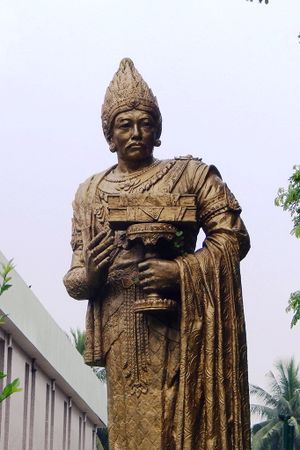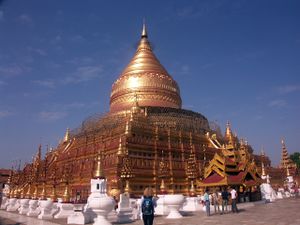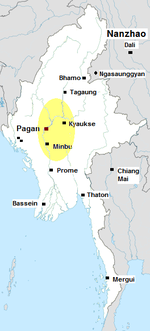أنورتا
| Anawrahta အနော်ရထာ | |||||
|---|---|---|---|---|---|
 Statue of Anawrahta | |||||
| King of Burma | |||||
| العهد | 11 August 1044 – 11 April 1077 | ||||
| التتويج | 16 December 1044 | ||||
| سبقه | Sokkate | ||||
| Successor | ساولو | ||||
| وُلِد | 11 May 1014 Tuesday, 11th waxing of Nayon 376 ME پاگان (باگان) | ||||
| توفي | 11 أبريل 1077 (aged 62) Tuesday, 3rd waning of Kason 439 ME Pagan | ||||
| القرينة | Agga Mahethi[1] Pyinsa Kalayani Saw Mon Hla Manisanda | ||||
| الأنجال | Sawlu Kyansittha | ||||
| |||||
| البيت | پاگان | ||||
| الأب | Kunhsaw Kyaunghpyu | ||||
| الأم | Myauk Pyinthe | ||||
| الديانة | Theravada Buddhism converted from Ari Buddhism | ||||
Anawrahta Minsaw (بالبورمية: အနော်ရထာ မင်းစော, تـُنطق [ʔənɔ̀jətʰà mɪ́ɴ sɔ́]; 11 May 1014 – 11 April 1077) was the founder of the Pagan Empire. Considered the father of the Burmese nation, Anawrahta turned a small principality in the dry zone of Upper Burma into the first Burmese Empire that formed the basis of modern-day Burma (Myanmar).[2][3] Historically verifiable Burmese history begins with his accession to the Pagan throne in 1044.[4]
Anawrahta unified the entire Irrawaddy valley for the first time in history, and placed peripheral regions such as the Shan States and Arakan (Northern Rakhine) under Pagan's suzerainty. He successfully stopped the advance of Khmer Empire into Tenasserim coastline and into Upper Menam valley, making Pagan one of two main kingdoms in mainland Southeast Asia.
A strict disciplinarian, Anawrahta implemented a series of key social, religious and economic reforms that would have a lasting impact in Burmese history. His social and religious reforms later developed into the modern-day Burmese culture. By building a series of weirs, he turned parched, arid regions around Pagan into the main rice granaries of Upper Burma, giving Upper Burma an enduring economic base from which to dominate the Irrawaddy valley and its periphery in the following centuries. He bequeathed a strong administrative system that all later Pagan kings followed until the dynasty's fall in 1287. The success and longevity of Pagan's dominance over the Irrawaddy valley laid the foundation for the ascent of Burmese language and culture, the spread of Burman ethnicity in Upper Burma.
Anawrahta's legacy went far beyond the borders of modern Burma. His embrace of Theravada Buddhism and his success in stopping the advance of Khmer Empire, a Hindu state, provided the Buddhist school, which had been in retreat elsewhere in South and Southeast Asia, a much needed reprieve and a safe shelter. He helped restart Theravada Buddhism in Ceylon, the Buddhist school's original home. The success of Pagan dynasty made Theravada Buddhism's later growth in Lan Na (northern Thailand), Siam (central Thailand), Lan Xang (Laos), and Khmer Empire (Cambodia) in the 13th and 14th centuries possible.
Anawrahta is one of the most famous kings in Burmese history. His life stories (legends) are a staple of Burmese folklore and retold in popular literature and theater.
النشأة
| Chronicles | Birth–Death | Age | Reign | Length of reign |
|---|---|---|---|---|
| Zatadawbon Yazawin | 1014/15–1077/78[note 1] | 62 | 1044/45–1077/78 | 33 |
| Maha Yazawin | 970/71–1035/36 | 65 | 1002/03–1035/36 | 33 |
| Yazawin Thit and Hmannan Yazawin | 985/86–March 1060 | 74 | 13 January 1018–March 1060[note 2] | 42 |
| Scholarship | 11 May 1014 – 11 April 1077 | 62 | 11 August 1044 – 11 April 1077 | 32 |
بداية عهده: توحيد بورما الوسطى
الاصلاحات الاقتصادية
الهيكل العسكري
Anawrahta organized Pagan's military. His key men—known as the Four Great Paladins in Burmese history—were:[5]
- Kyansittha, his son and lead general
- Nyaung-U Hpi, known as the great swimmer from Nyaung-U
- Nga Htwe Yu, former toddy tree climber from Myinmu (near Sagaing)
- Nga Lon Letpe, former farmer from near Mount Popa
تأسيس امبراطورية پاگان
By the mid-1050s, Anawrahta's reforms had turned Pagan into a regional power, and he looked to expand. Over the next ten years, he founded the Pagan Empire, the Irrawaddy valley at the core, surrounded by tributary kingdoms.[6]
تلال شان
His first efforts were in then lightly inhabited Shan Hills in the east and the north. He acquired allegiance of Shan Hills in two waves. In the early to mid-1050s, Anawrahta first visited the nearer Shan Hills in the east, and received tribute. He founded the Bawrithat Pagoda in Nyaungshwe. The second wave came in the late 1050s and early 1060s after his march to Nanzhao Kingdom. After his return from Nanzhao expedition, Shan chiefs along the route presented Anawrahta with tributes. Still, their allegiance was nominal and he had to establish 43 forts along the eastern foothills of which the following 33 still exist as villages.[7]
| Bhamo | Katha | Kyaukse | Meiktila | Mogok | Mandalay | Toungoo | Yamethin |
|---|---|---|---|---|---|---|---|
|
|
|
|
|
|
|
|
The 43 forts were established per the royal order issued 7 February 1061 (12th waxing of Tabaung 422 ME).[8]
بورما السفلى
أراكان
Anawrahta's next conquest was north Arakan (Rakhine). He marched over the pass from Ngape near Minbu to An in Kyaukphyu, and then laid siege to Pyinsa, then the capital of Arakan. He reportedly tried to bring home the giant Mahamuni Buddha but could not. He did take away the gold and silver vessels of the shrine.[9]
Pateikkaya
العلاقات الخارجية
As his kingdom expanded, Anawrahta came into contact with the Nanzhao Kingdom (the erstwhile home of the Burmans) in the northeast, and in the southeast, the Khmer Empire, the main power of mainland Southeast Asia at the time. He assisted fellow Theravada Buddhist Ceylon in its war against Hindu Chola invaders.
امبراطورية الخمير
Pagan's conquest of Thaton shook the Mon world. Anawrahta also demanded tribute from other neighboring Mon Kingdoms, Haripunjaya and Dvaravati (in present-day northern and central تايلند). Haripunjaya reportedly sent in tribute but Dvaravati's overlord Khmer Empire instead invaded Tenasserim. Anawrahta sent his armies, again led by the four paladins, who repulsed the invaders. The Burmese chronicles referred to the Kingdom of Cambodia as the southeastern limit of the Pagan Empire.[10]
Nanzhao Kingdom
After the Khmer advance was checked, Anawrahta turned his attention toward Nanzhao. Anawrahta led a campaign against the kingdom in the northeast. (According to a mid-17th century source, he began the march on 16 December 1757.)[note 3] He advanced to Dali, the capital of Nanzhao Kingdom, ostensibly to seek a Buddha's tooth relic. As in the case of the request for the scriptures from Thaton, it was really a demand for tribute. The ruler of Nanzhao shut the gates, and would not give up the relic. After a long pause, two kings exchanged presents and conversed amicably. The Nanzhao ruler gave Anawrahta a jade image which had come into contact with the tooth.[11]
سيلان
In 1069, Vijayabahu I of Ceylon asked Anawrahta for aid against the Chola invaders from Tamil country. Anawrahta sent ships of supplies in aid of Buddhist Ceylon.[11][12] In 1071, Vijayabahu who had defeated the Cholas asked Anawrahta for scriptures and monks. The Chola invasions had left the original home of Theravada Buddhism with so few monks that it was hard to convene a chapter and make valid ordinations. Anawrahta sent the monks and scriptures, and a white elephant as present for Vijayabahu. The Burmese monks ordained or re-ordained the entire clergy of the island. In return, the Ceylonese king gave a replica of the Buddha Tooth of which Ceylon was the proud possessor. The replica was then enshrined in the Lawkananda Pagoda in Pagan.[11][13]
الادارة
بناء الأمة
الإصلاحات الدينية

اختراع الخط البورمي
Scholarship believed until recently that Anawrahta commissioned the invention of the Burmese script based on the Mon script, c. 1058, a year after the Thaton conquest.[14] However, recent research finds that the Burmese script had been in use at least since 1035, and if an 18th-century recast inscription is permissible as evidence, since 984 CE.[15]
أسلوب الحكم
وفاته
ذكراه

تخليد ذكراه
- Anawrahta Road, a main avenue in Yangon
- UMS Anawrahta, Myanmar Navy Corvette
- Team Anawrahta, one of the five student teams in Burmese schools
ملاحظات
- ^ The Burmese calendar straddles the Western calendar year. In Anawrahta's time, each Burmese year began and ended in late March of the Julian calendar. For example, the Burmese year 376 spanned from 25 March 1014 to 25 March 1015. Scholarship usually simplifies by reporting just the leading year, e.g., 376 ME as 1014.
- ^ (Hmannan Vol. 1 2003: 230) on Monday, 8th waning of Pyatho, 379 ME (13 January 1018). (Hmannan Vol. 1 2003: 274) says Anawrahta died in 421 ME (1059–1060 CE) right before the Burmese new year (March 1060).
- ^ (Maha Yazawin Vol. 1 2006: 166 footnote #2): The date was given by the monk Taunghpila Sayadaw as part of his answers to a set questions posed by King Pindale (r. 1648–1661).
الهامش
- ^ Yazawin Thit Vol. 1 2012: 108, footnote #2
- ^ Harvey 1925: 34
- ^ Htin Aung 1967: 38
- ^ Coedès 1968: 133, 148–149, 155
- ^ Harvey 1925: 24
- ^ Htin Aung 1967: 34
- ^ Harvey 1925: 26–31
- ^ Hmannan Vol. 1 2003: 269–270
- ^ Harvey 1925: 29
- ^ خطأ استشهاد: وسم
<ref>غير صحيح؛ لا نص تم توفيره للمراجع المسماةmha-33 - ^ أ ب ت خطأ استشهاد: وسم
<ref>غير صحيح؛ لا نص تم توفيره للمراجع المسماةmha-35 - ^ Kyaw Thet 1962: 46–47
- ^ Harvey 1925: 32
- ^ Harvey 1925: 307
- ^ Aung-Thwin (2005): 167–178, 197–200
ببليوگرافيا
- Aung-Thwin, Michael (1985). Pagan: The Origins of Modern Burma. Honolulu: University of Hawai'i Press. ISBN 0-8248-0960-2.
- Aung-Thwin, Michael A. (2005). The Mists of Rāmañña: The Legend that was Lower Burma (illustrated ed.). Honolulu: University of Hawai'i Press. ISBN 978-0-8248-2886-8.
- Bo Lay, Dr. Meitthalat Lettwei Thutethana Kyan (in Burmese). Yangon: Su Paung.
{{cite book}}: CS1 maint: unrecognized language (link) - Coedès, George (1968). Walter F. Vella (ed.). The Indianized States of Southeast Asia. trans.Susan Brown Cowing. University of Hawaii Press. ISBN 978-0-8248-0368-1.
- Eade, J.C. Southeast Asian Ephemeris: Solar and Planetary Positions, A.D. 638–2000. Cornell University Press. ISBN 0-87727-704-4.
- Hall, D.G.E. (1960). Burma (3rd ed.). Hutchinson University Library. ISBN 978-1-4067-3503-1.
- Harvey, G. E. (1925). History of Burma: From the Earliest Times to 10 March 1824. London: Frank Cass & Co. Ltd.
- Htin Aung, Maung (1967). A History of Burma. New York and London: Cambridge University Press.
- Kala, U (1724). Maha Yazawin (in Burmese). Vol. 1–3 (2006, 4th printing ed.). Yangon: Ya-Pyei Publishing.
{{cite book}}: CS1 maint: unrecognized language (link) - Kyaw Thet (1962). History of Burma (in Burmese). Yangon: Yangon University Press.
{{cite book}}: CS1 maint: unrecognized language (link) - Lieberman, Victor B. (2003). Strange Parallels: Southeast Asia in Global Context, c. 800–1830, volume 1, Integration on the Mainland. Cambridge University Press. ISBN 978-0-521-80496-7.
- Maha Sithu (1798). Myint Swe (; Kyaw Win; Thein Hlaing (eds.). Yazawin Thit (in Burmese). Vol. 1–3 (2012, 2nd printing ed.). Yangon: Ya-Pyei Publishing.
{{cite book}}: CS1 maint: unrecognized language (link) - Myint-U, Thant (2006). The River of Lost Footsteps—Histories of Burma. Farrar, Straus and Giroux. ISBN 978-0-374-16342-6.
- Pe Maung Tin; G.H. Luce (1923). The Glass Palace Chronicle of the Kings of Burma (1960 ed.). Rangoon University Press.
- Phayre, Lt. Gen. Sir Arthur P. (1883). History of Burma (1967 ed.). London: Susil Gupta.
- Ricklefs, M.C.; Bruce McFarland Lockhart; Albert Lau; Portia Reyes; Maitrii Aung-Thwin; Bruce Lockhart (2010). A New History of Southeast Asia. Palgrave Macmillan. ISBN 978-0230212145.
- Royal Historians of Burma (c. 1680). Zatadawbon Yazawin (1960 ed.). Historical Research Directorate of the Union of Burma.
{{cite book}}: Unknown parameter|editors=ignored (|editor=suggested) (help) - Royal Historical Commission of Burma (1832). Hmannan Yazawin (in Burmese). Vol. 1–3 (2003 ed.). Yangon: Ministry of Information, Myanmar.
{{cite book}}: CS1 maint: unrecognized language (link) - Sandamala Linkara, Ashin (1931). Rakhine Yazawinthit Kyan (in Burmese). Vol. 1–2 (1997 ed.). Yangon: Tetlan Sarpay.
{{cite book}}: CS1 maint: unrecognized language (link) - South, Ashley (2003). Mon nationalism and civil war in Burma: the golden sheldrake. Routledge. ISBN 978-0-7007-1609-8.
- Tarling, Nicholas (1999). The Cambridge History of Southeast Asia: Early Times to c. 1500. ISBN 978-0-521-66369-4.
أنورتا وُلِد: 11 May 1014 توفي: 11 April 1077
| ||
| ألقاب ملكية | ||
|---|---|---|
| سبقه Sokkate |
King of Burma 1044–1077 |
تبعه Sawlu |

